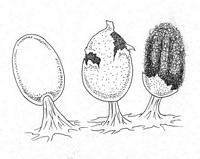|
 Diachea leucopodia Diachea leucopodia
SynonymsTrichia leucopodia
Diachea elegans
Stemonitis elegans
BiostatusPresent in region - Indigenous. Non endemic
Images (click to enlarge)
Caption: Three sporangia of Diachea leucopodia, each of which is about 1.5 mm tall. The prominent columella is visible in the sporangium on the right.
Owner: S.L. Stephenson |
Article: Stephenson, S.L. (2003). Myxomycetes of New Zealand. Fungi of New Zealand. Ngā Harore o Aotearoa 3: xiv + 238 p. Hong Kong: Fungal Diversity Press.
Description: Fruiting body a stalked sporangium, gregarious, 0.7–2.0 mm tall. Sporotheca elliptical to cylindrical, erect, 0.3–0.6 mm in diameter. Stalk stout, tapering upward, white, filled with granular lime, one-quarter to one-half the total height of the fruiting body. Hypothallus usually conspicuous but sometimes sparse, white, calcareous. Peridium membranous, iridescent blue, purple, or bronze. Columella cylindrical or tapered upward, white, calcareous, one-half or more of the total height of the sporotheca. Capillitium dense, consisting of branching and anastomosing flexuous threads, brown with pale tips, arising from all parts of the columella. Spores nearly black in mass, dull violet by transmitted light, minutely roughened, 7–11 µm in diameter. Plasmodium white.
Habitat: Dead leaves, twigs, and other plant debris; also commonly fruiting on living plants.
Distribution: Reported as cosmopolitan (Martin & Alexopoulos 1969) but apparently absent from high-latitude regions of the world (Stephenson et al. 2000). First reported (as Diachea elegans) from New Zealand by Lister & Lister (1905), based on a specimen collected in Dunedin. Also known from Auckland, Waikato, Bay of Plenty, Taupo, Wellington, Hawkes Bay, Southland, and Stewart Island.
Notes: Diachea leucopodia is a distinctive species and is not likely to be confused with any other myxomycete.
|